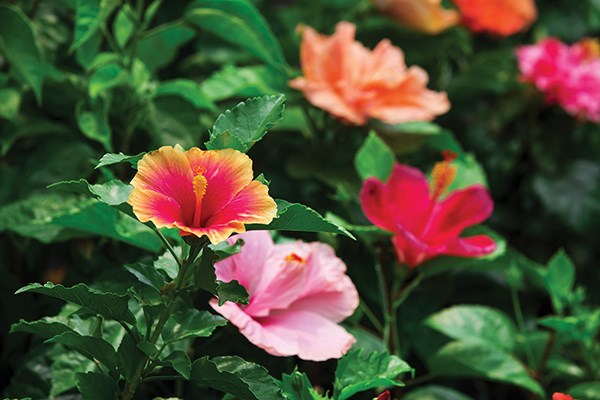We have been vacationing in the lovely seaside town of Cunit, Spain. About 45 minutes south of the pearl of Catalunya, Barcelona. It’s very dry and arid in these parts, but wherever I go I am checking out the beautiful tropical plants and flowers, most of which wouldn’t do well in our rainforest climate at home.
One exception to that rule is hibiscus. The lady down the lane has the largest and most beautiful hibiscus, and it tumbles over her fence so I can enjoy it as I walk by. Hibiscus is a genus of plants in the mallow family.
The genus is huge and contains over several hundred species that are native to subtropical and tropical regions throughout the world.
Loved for their showy flowers, they are commonly called rose mallow. This genus includes both annual and perennial herbaceous plants as well as woody shrubs and small trees.
Some tropical varieties will not grow in our parts, but others like hibiscus syriacus althea (or rose of Sharon) are a beautiful underused woody shrub that grows well in Squamish.
Cultivated in England since the 16th century, rose of Sharon is no new kid on the block. It is one of those great late- blooming shrubs that struts its stuff from July to October, at a time when not much else shines.
Hardy to zone six and preferring full sun, this shrub will be a highlight of the fall garden. Don’t worry in the spring if it looks as thought it’s seen better days; this is one of those shrubs that leafs out very late.
Try planting it in front of evergreens, like laurel or cedar, and the flowers will make a striking contrast amongst the green.
Hibiscus syriacus as been grown for centuries in Syria where it is considered native, but plant hunters tell us its origin is China.
I have seen it used extensively in France in parks and public spaces, but at home we are slow to cotton on to this great shrub.
Rose of Sharon loves a long hot summer, and once established it is very drought tolerant. They come in single and double bloom varieties and each is equally lovely. “Bluebird” is a popular cultivar that has light blue flowers with a dark centre and has proven itself very reliable.
Smaller plants take a few years to establish themselves, so don’t be disappointed by the lack of blooms in the first few years.
Patience is key here, and once happy and established you will be rewarded with tropical-like blooms for many years to come.




